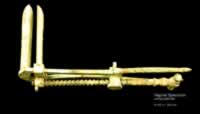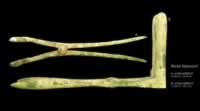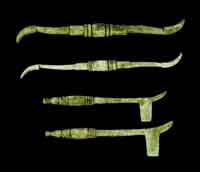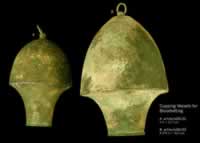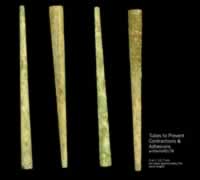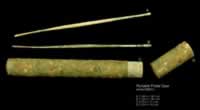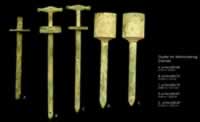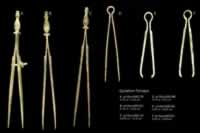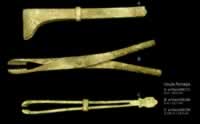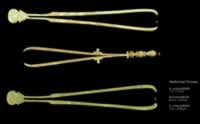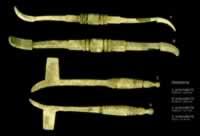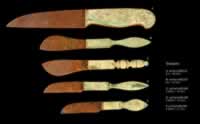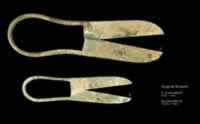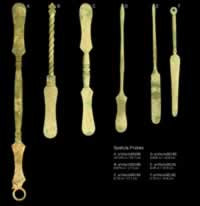Surgical Instruments from Ancient Rome
A Display of Surgical Instruments from Antiquity
NOTICE: All images in the exhibit are the property of Historical Collections & Services of the Health Sciences Library, University of Virginia. Please contact a member of Historical Collections for permission to reproduce in any fashion images from the exhibit or to make comments or suggestions.
Introduction
The eruption of Mount Vesuvius in 79 CE buried the Roman cities of Pompeii and Herculaneum under feet of ash and pumice. Objects under the volcanic material were found to be well preserved when they were excavated centuries later. Among the artifacts recovered were surgical instruments from multiple sites, the best known being Pompeii’s House of the Surgeon, so named because of the nature of the items recovered there. In 1947, reproductions of these instruments were presented to the Claude Moore Health Sciences Library by the University of Virginia’s 8th Evacuation Hospital after its service in Italy during World War II. The collection is one of the best surviving examples of the tools at a surgeon’s disposal in the first century CE. Since there was relatively little innovation in surgery and surgical tools from the time of Hippocrates (5th century BCE) and Galen (2nd century CE), this collection is typical of surgical practice for nearly a millennium and illuminates the practice of medicine in ancient Rome. In fact, the technology of some tools, such as the vaginal speculum, did not change significantly until the 20th century.
The following display presents images and summaries of the known uses of each instrument. The extant comments of medical writers from antiquity–including Oribasius, Galen, Soranus, Aetius, and the Hippocratic corpus–have provided scholars with some clues about the use of some instruments. Some instruments, such as mixing instruments and tweezers, probably had other household uses, such as the application of cosmetics and paints.
Vaginal Speculum
One of the most spectacular, if fearsome looking, Roman medical instruments is the vaginal dilator or speculum (dioptra). It comprises a priapiscus with 2 (or sometimes 3 or 4) dovetailing valves which are opened and closed by a handle with a screw mechanism, an arrangement that was still to be found in the specula of 18th-century Europe. Soranus is the first author who makes mention of the speculum specially made for the vagina. Graeco-Roman writers on gynecology and obstetrics frequently recommend its use in the diagnosis and treatment of vaginal and uterine disorders, yet it is one of the rarest surviving medical instruments. Specula are large and readily recognizable and should not have suffered the same degree of destruction as thin instruments, such as probes, scalpels and needles. As a source of bronze, however, they may have been more subject to recycling than the smaller instruments.
Rectal Speculum
The earliest mention of the rectal speculum is to be found in the treatise on fistula by Hippocrates (iii.331): “…laying the patient on his back and examining the ulcerated part of the bowel by means of the rectal speculum …”
Bone Levers
From what Galen says, these instruments were used for levering fractured bones into position and may have been used for levering out teeth.
Bone Forceps
Soranus (lxiv) says that in case of impaction of the foetal cranium, the head may be opened with a sharp instrument and the pieces of the skull removed with bone forceps. Paul Aigenita (VI.xc) says that in a depressed fracture of the skull “fractured bone is to be removed in fragments, with the fingers if possible, if not, with a bone forceps.”
Cupping Vessels for Bloodletting
The larger cupping vesssel would have been used for larger areas on the body, such as the back or thighs. The smaller vessel would have been applied to the arms.
Tubes to Prevent Contractions & Adhesions
After operations on the nose, rectum, vagina, etc., it was usual to insert a tube of lead or bronze to prevent contraction or adhesion and also to convey medicaments.
Tile Cautery
The cautery was employed to an almost incredible extent in ancient times, and surgeons expended much ingenuity in devising different forms of this instrument. The cautery was employed for almost every possible purpose: as a ‘counter-irritant’, as a haemostatic, as a bloodless knife, as a means of destroying tumours, etc.
Portable Probe Case
This plain cylindrical case was used to store and protect the thin probes and curettes used by physicians. Hippocrates mentions a portable equipment case for use on housecalls.
Male Catheter
Clyster for Administering Enemas
Obstetrical Hooks/Sharp Hooks
Hooks, blunt and sharp, are frequently mentioned in both Greek and Latin literature, and served the same possible purposes we use them for: the blunt for dissecting and raising blood-vessels like the modern aneurism needle; the sharp for seizing and raising small pieces of tissue for excision and for fixing and retracting the edges of wounds. In dissection, many of the manipulations which we perform with the dissecting forceps were performed by the ancients with sharp hooks.
Epilation Forceps
By far the largest number of forceps of this type are not surgical instruments, but household implements. Many were used for epilation (hair removal) or by artists.
Uvula Forceps
In Aetius (II.iv.2), there is an interesting description of the amputation of the uvula by first crushing it in a forceps so as to prevent haemorrhage and then cutting it off. Hippocrates (I.63) mentions the uvula crusher as one of the instruments necessary for the outfit of the physician.
Abdominal Forceps
Osteotomes
Scalpels
Surgical Scissors
The surgical author Oribasius treats the cutting of hair as a regular medical procedure in a special chapter of his work. Celsus also frequently refers to cutting the hair as a therapeutic measure. Possibly the ancients found difficulty in putting an edge sufficiently smooth for surgical purposes on their shears. We have few references to the use of the shears for cutting tissues.
Spatula Probes
Almost every medical writer mentions the spathomele. It consists of a long shaft with an olivary point at one end and a spatula at the other. It was a pharmaceutical rather than a strictly surgical instrument. The olive end was used for stirring medicaments, the spatula for spreading them on the affected part. The spathomele was used by painters for preparing and mixing their colors. The very large numbers in which they are found would indicate that their use was not confined to medical men.
Probes/Curettes
The scope of the cyathiscomele in medical art is evidently, like the flat spathomele, to act occasionally as a sound, but mainly to mix, measure and apply medicaments. Some are adapted for use as curettes. The large numbers in which this instrument occurs would itself indicate that it was used for lay as well as medical purposes.
We hope you enjoyed this exhibit. Thanks for your interest!
